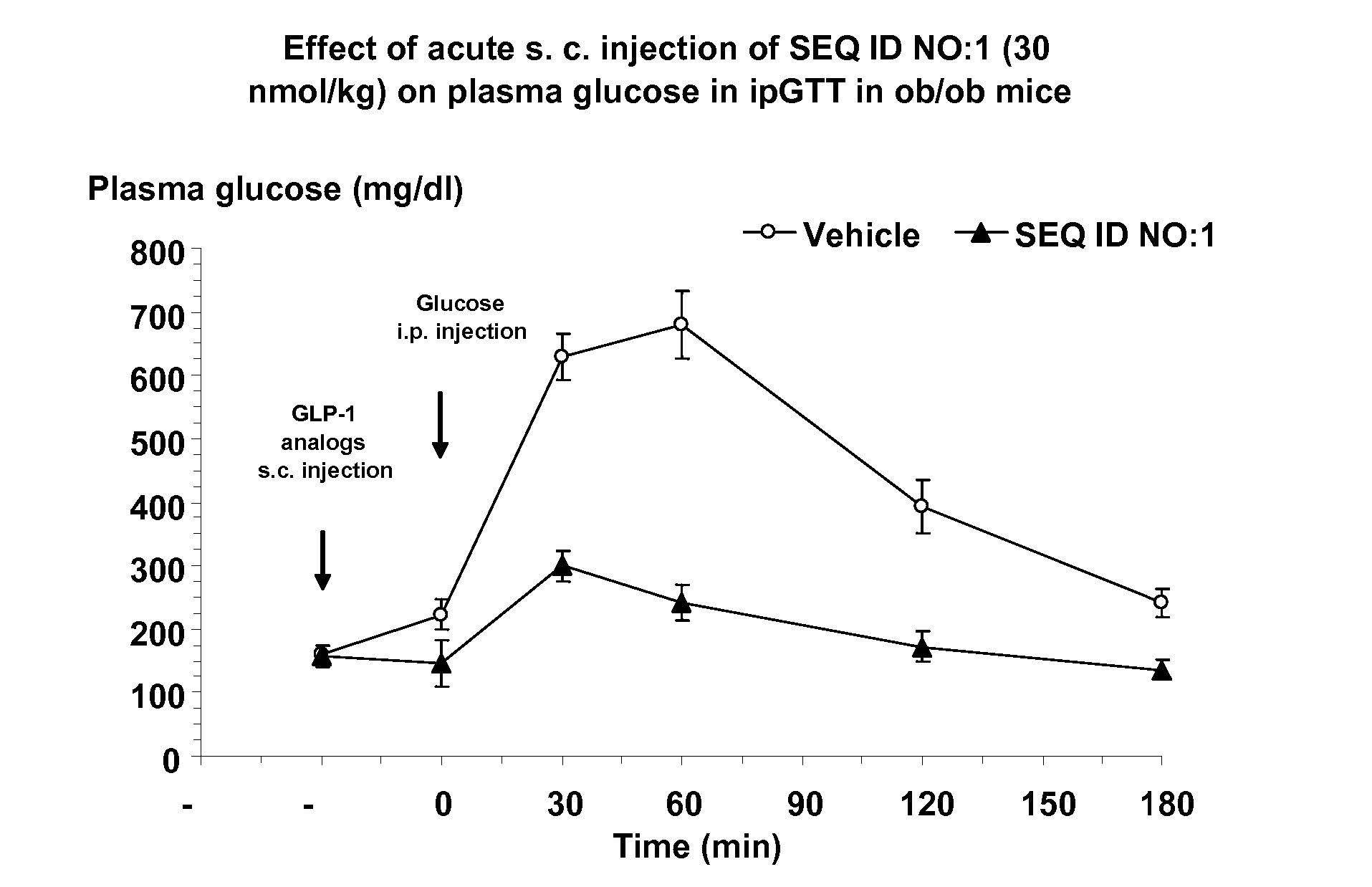Human glucagon-like-peptide-1 modulators and their use in the treatment of diabetes related conditions
a technology of glucagon-like peptides and receptors, which is applied in the direction of peptide/protein ingredients, extracellular fluid disorders, metabolic disorders, etc., can solve the problems of short serum half-life of such compounds and the significant challenge of therapy involving the use of glp-1-type molecules, and achieve the effect of increasing high density lipoprotein and elevating blood levels of fatty acids
- Summary
- Abstract
- Description
- Claims
- Application Information
AI Technical Summary
Benefits of technology
Problems solved by technology
Method used
Image
Examples
example 1
Solid Phase Synthesis of 11-Mer Peptide Analogs Using an Applied Biosystems Model 433A Peptide Synthesizer
[0321] The following is a general description of the solid phase synthesis of peptide analogs described herein, using an upgraded Applied Biosystems Model 433A peptide synthesizer. The upgraded hardware and software of the synthesizer enabled conductivity monitoring of the Fmoc deprotection step with feedback control of coupling. The protocols allowed a range of synthesis scale from 0.05 to 1.0 mmol.
[0322] The incorporation of the two non-natural C-terminal amino acids can be achieved using the procedures described in Examples 2-5. Such an Fmoc-protected dipeptidyl resin was used in this ABI synthesis. The Fmoc-protected dipeptidyl-resin (0.1 mmol) was added to a vessel of appropriate size on the instrument, washed six times with NMP, and deprotected using two treatments with 22% piperidine / NMP (2 and 8 minutes each). One or two additional monitored deprotection steps were per...
example 2
Synthesis of Biphenylalanine Analogs at Position Xaa10 and Homohomophenylalanine Analogs at Position Xaa11 Represented by Formulas II And III
[0326] For those analogs wherein position Xaa10 and position Xaa11 residues were represented by substituted amino acid analogs of Formulas II and III, i.e. biphenylalanine analogs (Bip analogs) or hetero-biphenylalanine analogs, or Homohomophenylalanine analogs (hhPhe analogs), their incorporation into the peptide chain was carried out using one of the following approaches.
1. General Procedure for Preparation of Rink Amide MBHA Resin Containing Amino Acids Represented by Formula III at Position Xaa11 (Hydroboration-Suzuki Couplings) (Scheme 1)
A. General Procedure for X1=X2=C in Formula III
[0327] Polystyrene-Rink amide MBHA resin (800 mg, 512 μmol, loading level of 640 μmol / g) was swelled in CH2Cl2 (8.0 mL) in a filter tube for ten minutes. The resin was drained and transferred to a 20 mL scintillation vial. Following transfer, 8:2 DMF / pi...
example 3
Synthesis of Biphenylalanine Analogs at Position Xaa10 and Unnatural Amino Acid Analogs at Position Xaa11 Represented by Formulas II and IV
[0332] For those analogs having position Xaa10 and Xaa11 residues as substituted amino acid analogs of Formulas II and IV, i.e. biphenylalanine analogs (Bip analogs) hetero-biphenylalanine analogs at position 10, and aspartic, or glutamic amide, ester, sulfonamide, or reverse amide or serine or threonine ether or ester analogs at position 11, their incorporation into the peptide chain was carried out using the following approach.
1. General Procedure for Preparation of Rink Amide MBHA Resin Containing Aspartic or Glutamic Acid Derivatives Represented by Formula IV at Position Xaa11 (Scheme 4)
A. General Procedure for Loading MBHA Resin
[0333] Polystyrene-Rink amide MBHA resin (400 mg, 256 μmol, loading level of 640 μmol / g) was added to a 20 mL scintillation vial, followed by addition of 8:2 DMF / piperidine (5.00 mL). The vial was capped and th...
PUM
| Property | Measurement | Unit |
|---|---|---|
| structure | aaaaa | aaaaa |
| stability | aaaaa | aaaaa |
Abstract
Description
Claims
Application Information
 Login to View More
Login to View More - R&D
- Intellectual Property
- Life Sciences
- Materials
- Tech Scout
- Unparalleled Data Quality
- Higher Quality Content
- 60% Fewer Hallucinations
Browse by: Latest US Patents, China's latest patents, Technical Efficacy Thesaurus, Application Domain, Technology Topic, Popular Technical Reports.
© 2025 PatSnap. All rights reserved.Legal|Privacy policy|Modern Slavery Act Transparency Statement|Sitemap|About US| Contact US: help@patsnap.com



